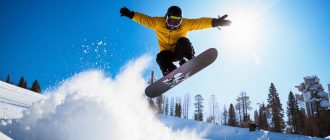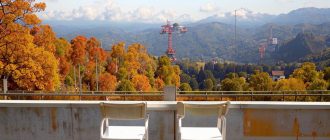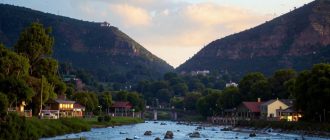As we have said many times, the mountains are a harsh world. The right thing to do is to listen to it and try to befriend it. Since there are many emergencies that can happen while you are on the snowy slopes that no one is immune to, you should be aware of them and keep them in mind at all times. One of them is an avalanche. The skiing season is about to start and we decided to raise the topic of safety in advance.
What an avalanche is, how mountain services and resort administrations deal with them, we will tell you below. And, of course, we will give useful tips. Let’s go.
What is an avalanche and how dangerous it is
Avalanche is a large snow mass that falls or slides down mountain slopes at a speed of about 20-30 meters per second. It is often accompanied by an “air pre avalanche wave”, which can cause additional damage in the place of avalanche.

The main danger to humans lies in the very mass of snow, which can sometimes reach several hundred tons. The consequences are clear – death from shock due to multiple fractures, as well as from lack of oxygen. There are also multiple cases of avalanches that can blow you off the slope, and as a result you can be crushed by falling from a great height.
To better understand the volumes and magnitude, let’s add some numbers. Avalanches are common to all mountainous areas – both within our country and the rest of the planet. For example, the total area of avalanche-prone areas in Russia is about 307.7 thousand km², and if you look at the map – about 18% of the total area of the country. Another 829.4 thousand km² are potentially avalanche-prone. On the planet, avalanche-prone zones cover a total area of 925.3 thousand km² (about 7% of the total land area).
Can an avalanche descend on a ski resort?

owner of the outdoors project Arbaika Backcountry, ex-head of the avalanche control service of Rosa Khutor
Snow is held on the slope or avalanches because of the action of various forces on it. In simpler terms, snow comes down from the action of gravitational forces on it, and is held by friction. In general, it is a complex geophysical process with a number of constructive moments aimed at snow retention and destructive factors, respectively, aimed at avalanches.
Two basic conditions are necessary for avalanches to occur:
Ironically, the same conditions are required for skiing and snowboarding. Accordingly, avalanches at a resort are a normal occurrence with a high probability of occurrence. In turn, the ski resort, providing paid services, is responsible for the safety of visitors in the area of its jurisdiction, i.e. on the slopes, cable cars and other infrastructure. To this end, a number of preventive measures are carried out, active and passive (means of combat and defense, respectively).
- The “active” ones include forced (controlled) avalanche descent by various means and methods.
- Passive” includes engineering protection of infrastructure facilities – avalanche-diverting structures, path profiling, snow-retaining structures, regulation of snow mass distribution, as well as restrictive measures and notification of resort visitors.

For proper understanding of avalanche situation, hydrometeorological forecasts, as well as prompt response to changes in the snow avalanche situation, each resort has an avalanche control service.
In addition to the methods described above, educational work is carried out on a regular basis to improve the level of culture of the rider community. This and much more is designed to minimize damage from avalanches and reduce the likelihood of uncontrolled avalanches, dangerous for visitors.
How to determine if a ski area is at risk of avalanche damage
Personally, I think it is important for ski enthusiasts to first of all follow the resort rules, be careful, cautious and increase their culture of behavior in the mountains. Besides avalanches, there are many other dangers in the mountains.
As mentioned above, avalanches are a complex process that depends on many variables that are sometimes very difficult or even impossible to track. Therefore, the process of determining avalanche zones is the domain of professionals, exclusively avalanche experts. At the moment of skiing itself it is the guide’s task. In my opinion, only he can make the right tactical decisions based on the information available to him and minimize the risk for the group or the one he leads. The guide must also have the skills, physical, technical and psychological capabilities to react quickly, provide assistance and rescue in an emergency situation.
What to do if you find yourself in an avalanche zone
- If you or your group is in the avalanche zone and you realize that you can get into it, the first thing you should do is to get out. This should be done in cold blood and without panic. An experienced rider analyzes the situation and makes decisions in a split second. Evaluate the terrain and try to ride into the hills in the landscape.
- Do not immediately slide sideways in a traverse, it is better to accelerate slightly down the slope and smoothly arc to the nearest safe hill.
- Without stopping, give a sign to other members of the group. Do not try to rescue anyone before the avalanche has stopped. By rescuing yourself first, you increase the chances of finding others.
- If you manage to get to the surface before the end of the avalanche, keep a close eye on other members and try to remember where you last saw them. This will help narrow down your search area in the future.
- Further actions belong to the topic of search and rescue, which requires in-depth knowledge in this area, which any off-piste rider should have.

Important information to know
When riding off-piste, the first thing you need to have is a head on your shoulders. Also in your kit should be:
- a high level of skiing or snowboarding, if you don’t have that, learn;
- the knowledge and skills mentioned above, if not, learn. You may have a guide or a more experienced member who is the group leader, but everyone can be alone with the situation at a moment’s notice;
- physical fitness – if you don’t have any, train;
- tactical and technical training and logistically correct equipment: skis or snowboard for deep snow, clothing, communication, avalanche and mountaineering equipment;
- you must have objective information about the current snow avalanche situation and the forecast for the period of your stay on dangerous slopes;
- you must have a company of two or more like-minded people who are as well prepared as you are.
In conclusion, I would like to wish everyone to stay healthy, not to get into avalanches and not to endanger others.






